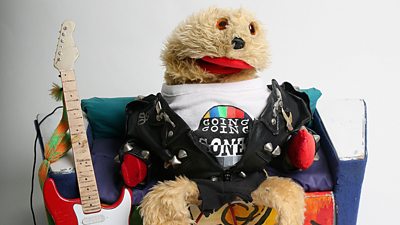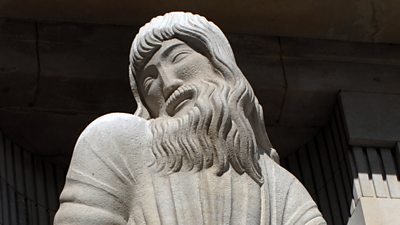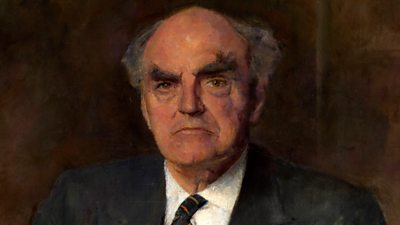At one time all television production was produced in-house and a very large collection of items were recycled over and over again for a very wide variety of programmes.
Dalek mould
The Dalek, probably the most iconic monster in the history of science fiction television, first appeared in episode 3 of the first series of Doctor Who in 1963. Conceived by 大象传媒 designer Ray Cusick, the Daleks were made from moulded sections. A few of the moulds have survived.
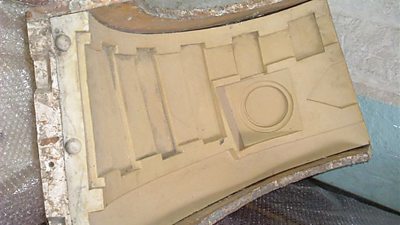
Pudsey
Pudsey is the official mascot of 大象传媒 Children in Need. The 大象传媒's first broadcast appeal for children took place in 1927, in the form of a five-minute radio broadcast on Christmas Day. The first televised appeal took place in 1955 and was called the Children's Hour Christmas Appeal.
Pudsey Bear appeared in 1985, and instantly transformed the Children in Need brand. He was created by 大象传媒 designer Joanna Ball, and took his name from her home town in Yorkshire. The 大象传媒 treasures two Pudsey bears in particular: the original, and a more recent example, signed by George Bush and Tony Blair.
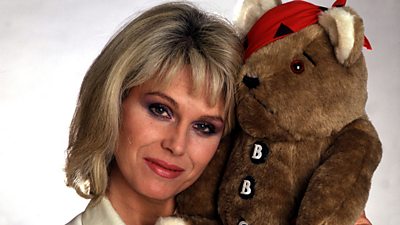
Kenny Everett's hands
Kenny Everett's giant foam hands - worn by his character Brother Lee Love in his groundbreaking TV shows - were much loved and much used, as his co-star, Cleo Rocos remembers: "Kenny adored the hands and was constantly getting into trouble with them.
He was always borrowing them for personal appearances, and famously waved them about at a Conservative student rally in 1983 as he bellowed with gusto, "Let's bomb Russia!". Photos of him with the hands appeared on every front page. He was mischievously pleased."
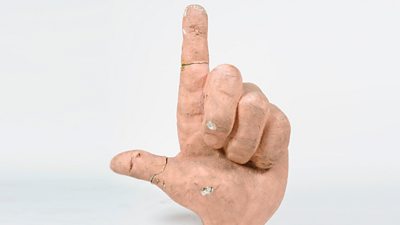
Mastermind buzzer
As the seconds ticked down for the contestants on early editions of Mastermind, Magnus Magnusson would be alerted by this hi-tech gizmo! It would often be followed by his immortal phrase, "I've started, so I'll finish." This device travelled around the country with the team in the 70s - the show was broadcast from a different location each week - and is now part of the 大象传媒 Heritage Collection.
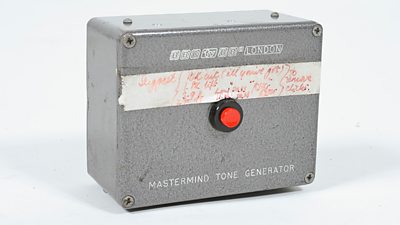
Blue Peter time capsule
John Noakes, Peter Purves and Valerie Singleton buried the box - containing such delights as a set of then-new decimal coins and a 1970 Blue Peter annual - in the grounds of Television Centre in June 1971. When they dug it up in 2000, Purves recalls,
The contents had turned to mush! It had been dug up and moved somewhere else, with everything repacked in plastic. A bit of air got into it, and the plastic sweats. Silly.
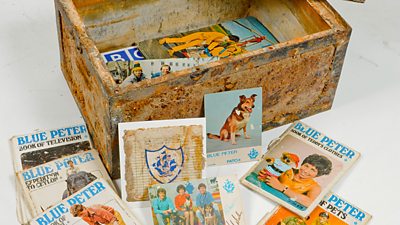
Trevor and Gemma's 1Xtra trainers
These are a pair of Nike trainers, specially customised by Glasgow designer Qustom Queen and presented to Radio 1Xtra's Trevor Nelson and Gemma during a Breakfast Show 'Road Trip' visit to Glasgow on 16 March 2009. They are apparently heat sensitive, with the baked beans disappearing when warmed up!
1Xtra's Breakfast Show runs every weekday from 7.00-10.00, featuring a range of contemporary black music: its strapline is 'love black music love 1Xtra'.
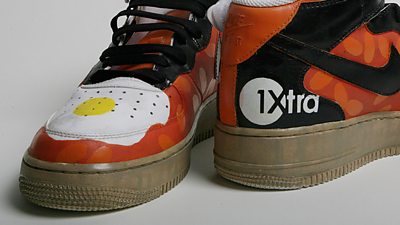
Blue Peter badges
A Blue Peter badge is the much sought-after prize on the long running children's show, Blue Peter. Badges are given for appearing on the show, or in recognition of a range of achievements. The idea of the badge began in 1963, and very quickly the simple white plastic shield bearing the distinctive blue ship logo became a highly desirable object.
It has had a variety of re-designs, plus there are now 6 different types of badge - including a green one for environmental work and a gold one awarded for acts of extreme bravery - but its ethos remains constant.
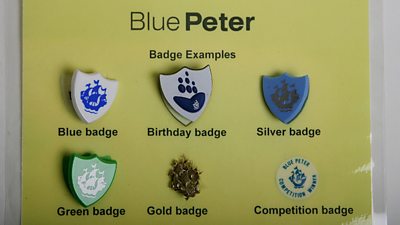
The dog that killed Dirty Den
This is the actual ornamental dog that Chrissie Watts used to kill off 'Dirty Den' Watts, in February 2005, in the show that marked the series's 20th anniversary. There were two versions of the dog made: one of plaster and one of rubber. This is the rubber one used in the fight scene where Den met his end. The creation of a rubber dog meant that actor Lesley Grantham lived on to act another day!
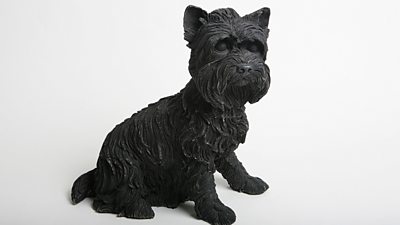
Albert Square sign
EastEnders' Albert Square is in the fictitious borough of Walford, in the postal district of E20 (the latter was originally fictitious as well, but is now the postcode of the Olympic Park at Stratford). It is based on real-life Fassett Square in Hackney, East London.
However, the Square is in reality a permanent set in Elstree Studios in NW London, where the drama is shot week in week out. Only the fronts of the houses have actually been built, and the majority of interior scenes are recorded in the studio.
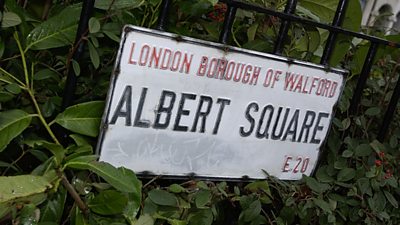
Frozen cat
This prop cat was found in Victor Meldrew's freezer, in the hit comedy One Foot in the Grave (starring Richard Wilson and annette Crosbie). It appeared in the first series in 1990, and received many complaints! The show was in fact no stranger to animal deaths - fatalities included two tortoises, a rotting hedgehog, a robin, a swan and this frozen cat. In addition, other animals that narrowly missed the grave included a puppy mistaken for a telephone, a crushed dachshund and a missing snake.
One Foot in the Grave was written by David Renwick. It ran for six series, with several specials over a ten year period, from 1990 to 2000. In 1992, it won the BAFTA for best TV comedy.
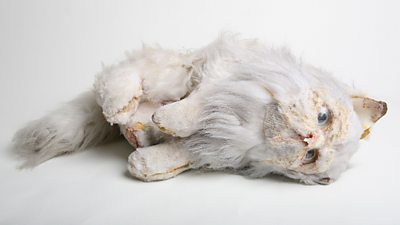
Alistair Cooke's typewriter
Boston University got all his papers but, according to his daughter Susan, it was only right that the typewriter belonging to the man who turned out his Letter from America for almost 58 years came back home to England. "This was the one he travelled with and the one I remember him working on in his apartment," she says. "He wasn't writing for America - it was for England and the 大象传媒."
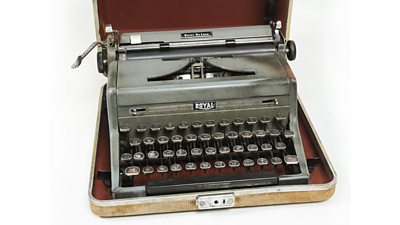
Household Talks book
A book for austerity times! This 1929 book is the second of two publications based on the 大象传媒's very popular household talks. The radio talks themselves were weekly, usually fifteen minutes long, and scheduled in the late afternoon. The majority were to do with cookery, but there were also practical hints on other domestic topics. Their overall aim was 'to help those who want to live economically, and yet enjoy the good things in life...'.
In the early days of the talks, listeners were invited to request copies of the recipes and tips featured, by sending a self-addressed envelope and a tuppenny stamp. The 大象传媒 used to get up to 5,000 requests, and with limited space in Radio Times, the books became a more economical option.
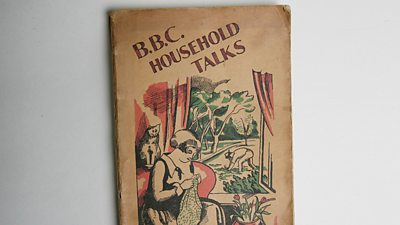
Teletubbies Toast
Teletubbies, launched in 1997, transformed children's programming on 大象传媒 television (and around the globe), with its delightful parade of colourful, child-friendly characters - Tinky Winky, Dipsy, Laa-Laa and Po, not forgetting a conscientious comic vacuum cleaner called Noo-noo.
Significantly, the Teletubbies emulated the world of the developing child, with minimal, repetitive language, large movement and bright colours. Here is a piece of Teletubbies toast - their favourite snack food!
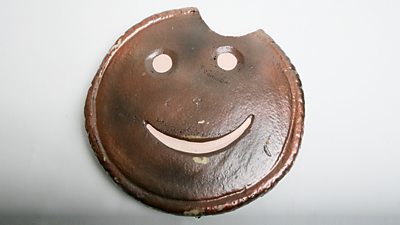
Gordon the Gopher puppet
This is the original puppet that partnered Philip Schofield in 1985. Together, they introduced children's programmes from The Broom Cupboard.
Gordon could not speak but communicated via excitable squeaks and developed quite a following among young children. In 1987, he transferred with Philip to his Saturday morning show Going Live.
Gordon鈥檚 first leather jacket was created by young fashion and product designer Jo Gough, which helped launch her career.
A subsequent jacket was a present from 1980s pop star, Adam Ant.
